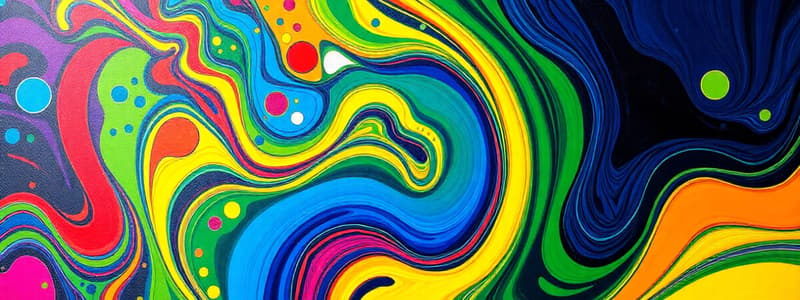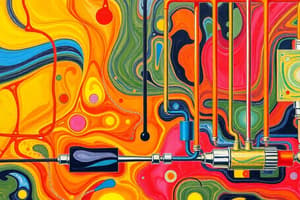Podcast
Questions and Answers
A fluid is characterized as any substance that ______, encompassing liquids, gases, slurries, mixtures, and even solids mixed with liquids.
A fluid is characterized as any substance that ______, encompassing liquids, gases, slurries, mixtures, and even solids mixed with liquids.
flows
Fluids are vital for ______ because they are able to be transported easily.
Fluids are vital for ______ because they are able to be transported easily.
transport
[Blank] systems rely on liquids under pressure to perform tasks such as lifting heavy objects, as seen in car jacks.
[Blank] systems rely on liquids under pressure to perform tasks such as lifting heavy objects, as seen in car jacks.
hydraulic
Conversely, ______ systems utilize air under pressure to operate tools, such as air brakes and drills.
Conversely, ______ systems utilize air under pressure to operate tools, such as air brakes and drills.
According to the particle theory, when the temperature of a liquid increases, its particles move faster, causing the liquid to become ______ viscous.
According to the particle theory, when the temperature of a liquid increases, its particles move faster, causing the liquid to become ______ viscous.
In contrast, when the temperature of a gas increases, the gas particles move faster, resulting in the gas becoming ______ viscous.
In contrast, when the temperature of a gas increases, the gas particles move faster, resulting in the gas becoming ______ viscous.
When the temperature increases, the particles move faster and hit the container walls more often and harder, therefore ______ increases.
When the temperature increases, the particles move faster and hit the container walls more often and harder, therefore ______ increases.
To determine the density of a substance, the formula used is Density = [Blank] / Volume.
To determine the density of a substance, the formula used is Density = [Blank] / Volume.
In a density column, liquids are layered based on their densities, with the heaviest liquid at the ______ and the lightest at the top.
In a density column, liquids are layered based on their densities, with the heaviest liquid at the ______ and the lightest at the top.
According to the principles of density, if an object is denser than a liquid, it will ______.
According to the principles of density, if an object is denser than a liquid, it will ______.
Solids are generally considered not ______ because their particles are tightly packed and vibrate in place.
Solids are generally considered not ______ because their particles are tightly packed and vibrate in place.
Gases are highly ______ because their particles are far apart and move freely.
Gases are highly ______ because their particles are far apart and move freely.
In an experiment with ramp and baby oil, it was observed that baby oil flows faster down a ______ ramp.
In an experiment with ramp and baby oil, it was observed that baby oil flows faster down a ______ ramp.
In a controlled experiment, only one ______ is changed to ensure that the effect of that variable can be accurately measured.
In a controlled experiment, only one ______ is changed to ensure that the effect of that variable can be accurately measured.
All other variables are kept ______ to ensure that the effect of that variable can be accurately measured.
All other variables are kept ______ to ensure that the effect of that variable can be accurately measured.
When testing the ramp angle's effect on the flow of oil, only change the ______, not the type of liquid or ramp material.
When testing the ramp angle's effect on the flow of oil, only change the ______, not the type of liquid or ramp material.
To calculate the mass of an object, given its density and ______, you would use the formula: Mass = [Blank] x Density
To calculate the mass of an object, given its density and ______, you would use the formula: Mass = [Blank] x Density
According to the scientific method, after formulating a question, the next step is to form a ______.
According to the scientific method, after formulating a question, the next step is to form a ______.
According to the scientific method, after conducting an experiment, the next step is to make an ______.
According to the scientific method, after conducting an experiment, the next step is to make an ______.
According to the scientific method, after collecting and analyzing data, the next step is to come to a ______.
According to the scientific method, after collecting and analyzing data, the next step is to come to a ______.
Flashcards
What is a fluid?
What is a fluid?
A substance that flows, including liquids, gases, slurries, mixtures of solids and liquids.
What are hydraulic systems?
What are hydraulic systems?
Systems that use liquids under pressure to lift heavy objects.
What are pneumatic systems?
What are pneumatic systems?
Systems that use air pressure for tools.
Liquid viscosity and temperature
Liquid viscosity and temperature
Signup and view all the flashcards
Gas viscosity and temperature
Gas viscosity and temperature
Signup and view all the flashcards
Temperature & Pressure
Temperature & Pressure
Signup and view all the flashcards
Density formula
Density formula
Signup and view all the flashcards
Density Column
Density Column
Signup and view all the flashcards
Sinking
Sinking
Signup and view all the flashcards
Floating
Floating
Signup and view all the flashcards
Solid compressibility
Solid compressibility
Signup and view all the flashcards
Liquid compressibility
Liquid compressibility
Signup and view all the flashcards
Gas compressibility
Gas compressibility
Signup and view all the flashcards
Ramp & Baby Oil Experiment
Ramp & Baby Oil Experiment
Signup and view all the flashcards
Controlled experiment
Controlled experiment
Signup and view all the flashcards
Study Notes
- A fluid is any substance that flows; this includes liquids, gases, slurry mixtures, or a solid and a liquid.
Importance and applications of Fluids
- Fluids are important because they help with transport
- Fluids are substances that can flow including liquids and gases
- Fluids do not have a fixed shape, and acquire the shape of their container
- Fluids can apply force
Hydraulic Systems
- Hydraulic systems use liquids under pressure to lift heavy objects, like car jacks.
Pneumatic Systems
- Pneumatic systems use air under pressure for tools like air brakes and drills.
Particle Theory & Viscosity
Temperature & Viscosity of Liquids
- As temperature increases, particles move faster, and liquids become less viscous and flow easier.
- For example, warm honey flows faster than cold honey.
Temperature & Viscosity of Gases
- As temperature increases, gas particles move faster, and gas becomes more viscous.
- For example, hot air is harder to flow than cold air in some systems.
Temperature and Pressure in Fluids (Constant Volume)
- As temperature increases, particles move faster and hit container walls more often and harder, which increases pressure.
Calculating Density, Mass, and Volume
- Density = Mass ÷ Volume
Formulas
- Mass = Volume divided by Density
- m=d×V
- Volume = Mass divided by Density
- V=mdV = \frac{m}{d}
Units
- Density is measured in g/cm³ or kg/m³.
- Mass is measured in g or kg.
- Volume is measured in cm³ or mL.
Density Column & Floating/Sinking
- A density column is a column of different liquids layered by density, with the heaviest liquid at the bottom and the lightest at the top.
Predicting Solid Behavior
- If an object is denser than a liquid, it sinks.
- You can predict where an object will float based on where its density fits in the column.
- For example, an object with a density of 1.2 g/cm³ floats between liquids with densities of 1.3 and 1.1 g/cm³.
Compressibility: Solids vs Fluids
Solids
- Solids are not compressible because their particles are tightly packed and vibrate in place.
Fluids (Liquids & Gases)
- Liquids are slightly compressible; their particles are close but can slide.
- Gases are highly compressible; their particles are far apart and move freely.
Investigation: Ramp & Baby Oil
- Baby oil flows faster down a steeper ramp
- Steeper angle shows that a stronger force of gravity pulling the liquid results in a faster flow rate.
- Slope thus affects flow in fluids.
Scientific Method & Controlled Experiments
Steps of the Scientific Method
- Ask a question
- Form a hypothesis
- Conduct an experiment
- Make an observation
- Collect and analyze data
- Conclude
- Repeat
Controlled Experiment (Fair Test)
- Only one variable should be changed
- All other variables must be kept constant
- For example, change only the angle when testing ramp angle, and not the liquid or ramp material.
Studying That Suits You
Use AI to generate personalized quizzes and flashcards to suit your learning preferences.




